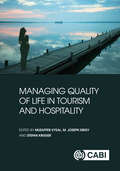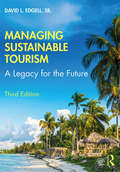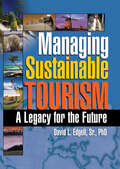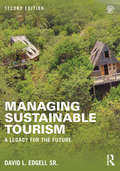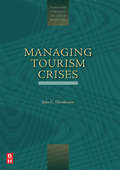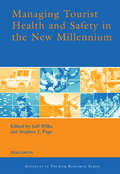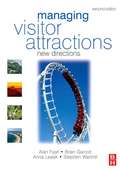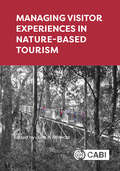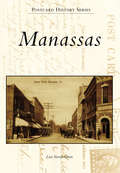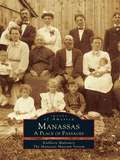- Table View
- List View
Managing Quality of Life in Tourism and Hospitality: Best Practice
by Muzaffer Uysal M. Joseph Sirgy Dr Stefan KrugerQuality-of-life research in tourism and hospitality has gained much momentum in the past two decades. This line of research covers three main areas of focus: (i) the impacts of specific tourism and hospitality programmes on the overall quality of life of tourists/guests; (ii) the providers of goods and services; (iii) tourist communities, including the impact of different programmes and events on the quality of life of residents in these communities. Focusing on these key subjects, Managing Quality of Life in Tourism and Hospitality provides a portfolio of selected cases showing best practice and delivering them to the forefront of knowledge application, with examples in tourism and hospitality settings. Best practice case studies are included throughout, providing practical implications and lessons learned. These lessons can be applied by tourism and hospitality practitioners and community leaders, and be used to further research by academics working within tourism and hospitality. The book offers an exciting and refreshing approach to quality-of-life research in tourism and hospitality. Key features include: - Best practice and evidence-based case studies. - Broad coverage that includes tourists, industry and local communities. - International application, with material from various countries across the world.
Managing Quality of Life in Tourism and Hospitality: Best Practice
by Muzaffer Uysal M. Joseph Sirgy Stefan KrugerQuality-of-life research in tourism and hospitality has gained much momentum in the past two decades. This line of research covers three main areas of focus: (i) the impacts of specific tourism and hospitality programmes on the overall quality of life of tourists/guests; (ii) the providers of goods and services; (iii) tourist communities, including the impact of different programmes and events on the quality of life of residents in these communities. Focusing on these key subjects, Managing Quality of Life in Tourism and Hospitality provides a portfolio of selected cases showing best practice and delivering them to the forefront of knowledge application, with examples in tourism and hospitality settings. Best practice case studies are included throughout, providing practical implications and lessons learned. These lessons can be applied by tourism and hospitality practitioners and community leaders, and be used to further research by academics working within tourism and hospitality. The book offers an exciting and refreshing approach to quality-of-life research in tourism and hospitality. Key features include: - Best practice and evidence-based case studies. - Broad coverage that includes tourists, industry and local communities. - International application, with material from various countries across the world.
Managing Religious Tourism (CABI Religious Tourism and Pilgrimage Series)
by Razaq Raj Ian Rotherham Alan Clarke Nigel Morpeth Silvia Aulet Kevin Griffin Rong Huang Dr Daniel H Olsen Vreny Enongene Xosé M. Santos Dr Maureen Griffiths Peter Wiltshier Dr Lucrezia Lopez Dr Elisa Piva Stefania Cerutti Dane Munro Dr Maaike De Jong Dr Alexander Grit Xin Lei Hu Sonia Puyol Ramon Canal Esperanca HolgadoManaging Religious Tourism provides a global view of the tools and resources used in demand and supply management, in the context of pilgrimage and religious tourism. With a focus on toolkits and best practices, the book reinforces the quality of service provision and offers a reflection on consumers' perspectives and what drives their purchasing decisions with regards to a variety of destinations. These central themes are complemented by an understanding of management responses to consumer behaviour and mobility, accessibility, individualism and tourism for both sacred and secular purposes. The book also examines the ways in which networks, partnerships and the conceptual stakeholder approach can be employed by religious tourism suppliers working with destination management organisations. The text promotes sustainable development and a triple bottom line focus, with all chapters supporting policy for framing development. Key features include: - Global perspective on tools as well as management approaches and techniques. - Emphasis on sustainability in connecting sacred and secular consumers. - Focus on promoting learning and development within this important tourism sector.
Managing Religious Tourism (CABI Religious Tourism and Pilgrimage Series)
by Razaq Raj Ian Rotherham Alan Clarke Nigel Morpeth Silvia Aulet Kevin Griffin Rong Huang Dr Daniel H Olsen Vreny Enongene Xosé M. Santos Dr Lucrezia Lopez Dr Elisa Piva Stefania Cerutti Dane Munro Dr Maaike De Jong Dr Alexander Grit Xin Lei Hu Sonia Puyol Ramon Canal Esperanca HolgadoManaging Religious Tourism provides a global view of the tools and resources used in demand and supply management, in the context of pilgrimage and religious tourism. With a focus on toolkits and best practices, the book reinforces the quality of service provision and offers a reflection on consumers' perspectives and what drives their purchasing decisions with regards to a variety of destinations. These central themes are complemented by an understanding of management responses to consumer behaviour and mobility, accessibility, individualism and tourism for both sacred and secular purposes. The book also examines the ways in which networks, partnerships and the conceptual stakeholder approach can be employed by religious tourism suppliers working with destination management organisations. The text promotes sustainable development and a triple bottom line focus, with all chapters supporting policy for framing development. Key features include: - Global perspective on tools as well as management approaches and techniques. - Emphasis on sustainability in connecting sacred and secular consumers. - Focus on promoting learning and development within this important tourism sector.
Managing Sports Organizations
by Daniel Covell Sharianne Walker Peter Hess Julie SicilianoManaging Sport Organizations, second edition, is a newly updated and comprehensive introduction to the themes and elements surrounding sport management. The book teaches management theory and principles in a coherent manner, helping to reinforce these concepts for students in schools of business, and serving to introduce them to students in other school settings (kinesiology, exercise science, sport science). The features of this book include: Important industry segment information is introduced chapter by chapter, allowing students to wed theory and application throughout Effectively weaves sport industry issues with fundamental management theories and practices Provides informative introductions to all fundamental aspects of sport management- Leadership, Information Technology, Media, Facility management, HR and much more With an online Instructor's Manual and a Test Bank available as well, this book is an essential tool for students and teachers of sport management.
Managing Sustainable Tourism: A Legacy for the Future
by David L. Edgell SrManaging Sustainable Tourism tackles the tough issues within the tourism industry, such as impacts on the natural and built environment and concerns for the history, heritage, and culture of local communities to provide answers that produce positive and quality economic growth for the tourism industry. It offers practical policies and plans for fostering harmonious relationships among local communities, the private sector, not-for-profit organizations academic institutions, and governments at all levels, as well as developing management practices and philosophies for the protection of natural, built, and cultural environments while reinforcing positive and orderly economic growth. It also confronts and explains the challenges on the tourism industry with respect to overtourism, climate change and global warming. Since the second edition, there have been many important developments in the field of sustainable tourism, and this third edition presents updated research and information in the following ways: Updated content to reflect issues and trends, including new directions in sustainable tourism development; New and updated international case studies of successes and failures to reflect current challenges and practices; A partial history of sustainable tourism from ancient times to the present; New concepts in sustainable tourism practices such as overtourism and undertourism; Transformative leadership and policies and their impact on sustainable tourism development. This volume provides a wealth of information and guidance on managing sustainable tourism and it will be invaluable to educators, students, developers, entrepreneurs, strategic planners and policymakers.
Managing Sustainable Tourism: A Legacy for the Future
by David L. Edgell, SrIntelligently designed tourism strategies for the twenty-first century!Successful tourism development and marketing are dependent on maintaining a delicate balance between economic growth and the protection of environments. Managing Sustainable Tourism: A Legacy for the Future tackles the tough issues of tourism such as negative environmental impact and cultural degradation, and provides answers that don&’t sacrifice positive economic growth. This essential book offers practical plans for fostering harmonious relationships among local communities, the private sector, not-for-profit organizations, academic institutions, and governments at all levels as well as develops management practices and philosophies that protect natural, built, and cultural environments while reinforcing positive and orderly economic growth.Managing Sustainable Tourism discusses in-depth the sensible guidelines for protecting environment, heritage sites, and local culture while developing realistic tourism goals for compatible economic growth. Useful strategies for sustainable tourism are detailed for each tourism type, along with useful tried-and-true marketing techniques aimed at cooperation and respect for all types of environments. Case studies, research, and supplemental reading lists clearly illustrate ideas and the author&’s qualified suggestions.Managing Sustainable Tourism explores: the future of the tourism industry understanding sustainable tourism the economics of community growth through tourism marketing the sustainable tourism product nature tourism heritage tourism cultural tourism rural tourism practical guidelines for sustainable tourism a workable global sustainable tourism initiativeManaging Sustainable Tourism is an ideal resource for educators, students, developers, entrepreneurs, investors, tourism strategists, planners, policymakers, and anyone interested in sustainable tourism for the new millennium.
Managing Sustainable Tourism: A legacy for the future
by David L. Edgell SrManaging Sustainable Tourism tackles the tough issues of tourism such as negative environmental impact and cultural degradation, and provides answers that don't sacrifice positive economic growth. It offers practical plans for fostering harmonious relationships among local communities, the private sector, not-for-profit organizations, academic institutions, and governments at all levels as well as develops management practices and philosophies that protect natural, built, and cultural environments while reinforcing positive and orderly economic growth. Since the first edition, there have been many important developments in the field, and this second edition has been revised and updated in the following ways: Updated content to reflect issues and trends, including: impact of the internet, slow tourism, responsible tourism, pro - poor tourism and motivations of the individual tourist New and updated international case studies of successes and failures to reflect current challenges and practices New lecturer and student online resources including PowerPoint slides and practical scenarios. This volume provides a wealth of information and guidance on managing sustainable tourism now and in the future and will be invaluable to educators, students, developers, entrepreneurs, investors, tourism strategists, planners and policymakers.
Managing Tourism Crises
by Joan C HendersonIn a world of increasing uncertainty it is vital that managers within the tourism industry are equipped with superior decision making skills and expertise necessary to deal with crisis conditions.Tourism Crises provides an effective synthesis of crisis management and tourism research with a solid theoretical foundation. It examines the principles and practices of crisis management within the context of tourism as a multi-sector industry. Using up to date international case studies, it tackles the following areas:· Political disturbance: the relationship between politics and tourism and political inspired tourism crises.· Social unrest: host-guest relations and tourists as targets of unrest· Economic instability: crises arising from fluctuating exchange rates and lack of investor confidence· Environmental conditions: natural disasters and health crises· Technological crises; transport accidents and crises arising from technical failure· Corporate crises. Human resource issues and questions of financeWith a user-friendly learning structure, each chapter will assess the presence of and tendency towards particular types of crisis, supported by a series of examples and cases, which describe organisational situations, challenges and responses. Approaches to managing crises will be assessed and appropriate tools and techniques of crisis management are explored, enabling readers to gain an insight into this critical aspect of tourism decision making and equipping them with the skills and expertise necessary to deal with crisis conditions.
Managing Tourism Enterprises: Start-up, Growth and Resilience
by Dr Rob Hallak Dr Craig LeeManaging Tourism Enterprises: Start-up, Growth and Resilience brings a new contribution to the literature on tourism management. It presents a comprehensive, educational text on the initiation, management, growth, performance and resilience of tourism enterprises in the age of digital disruption and global uncertainty. The book addresses the unique characteristics of tourism enterprises, how they are created, how they are managed, the factors that drive business performance, and how they must be innovative, resilient and adaptable in order to succeed. The content draws on empirical research, grey literature, government data and case studies to present theoretical and practical knowledge on the successful management of tourism enterprises and their role in tourism destinations. This book describes and includes essential business planning and teaching tools, such as: · The feasibility analysis, marketing plan, and strategic planning tools. · Lecture slides for each chapter. · Case studies with discussion questions. This is an essential book for undergraduate students completing 2nd and 3rd year courses on tourism management, with a focus on managing tourism enterprises; and postgraduate students undertaking courses specific to strategy and performance of tourism firms.
Managing Tourism and Hospitality Services: Theory and International Applications
by Gianna Moscardo Bruce Prideaux Eric LawsThe aim of this book is to enhance theoretical and practical understanding of quality management in tourism and hospitality. It provides a benchmark of current knowledge, and examines the range of research methods being applied to further develop tourism and hospitality service management research. It is hoped that this book will stimulate new research questions by highlighting tensions and challenges in the area.
Managing Tourist Health and Safety in the New Millennium (Advances In Tourism Research Ser.)
by Stephen J. Page Jeff WilksManaging Tourist Health is a seminal study which combines a range of state of the art reviews of the issues facing tourism managers and professionals in the fast growing area of tourist health and safety. An international range of contributors, each a specialist in their chosen field, have written papers for this book to explain many of the complex issues affecting tourists, the tourism industry and governments in ensuring tourism is viewed as a safe and enjoyable experience for all.The contributors have a wealth of interdisciplinary experience ranging from medicine, law, tourism research, safety science, ergonomics, management, consultancy among other cognate areas of study. Future research directions are examined in many of the chapters together with current state of the art knowledge in relation to key studies. The editors have worked in this area of research since the late 1980s and have accumulated a wide range of academic, professional and consultancy experience for governments and the private sector. The book extends this understanding through a multi-disciplinary perspective combining some of the leading researchers who have published in this area since the emergence of tourist health as a legitimate area of study in the 1970s.
Managing Visitor Attractions
by Brian Garrod Stephen WanhillVisitor attractions represent a complex sector of the tourism industry and are the catalytic focus for the development of tourism infrastructure and services. As this area grows, there are still many questions to be answered and issues to be understood – such as what visitor attractions actually are, what forces drive their development, who visits them and why, how they are funded, and what the numerous day-to-day challenges are in respect of their management andmarketing. The second edition of this successful text investigates these issues further and provides more solutions and suggestions for the present and future.Now in its 2nd edition, Managing Visitor Attractions: New Directions has been fully revised and updated to include new case studies on attractions in Singapore, seasonal variation,religion-based attractions, HRM issues and heritage tourism. It also includes five new chapterslooking at attraction success and failure, interpretation, school excursions, managing gardensand brand management.Divided into five parts, the book tackles the following core topics:• the role and nature of visitor attractions• the development of visitor attraction provision• the management of visitor attractions• the marketing of visitor attractions• future issues and trendsWith contributions from around the world, this is an essential text for undergraduate andpostgraduate students of visitor attraction management, written by subject specialists with awealth of experience in this field.
Managing Visitor Attractions: New Directions
by Alan FyallVisitor attractions represent a complex sector of the tourism industry and are the catalytic focus for the development of tourism infrastructure and services. The third edition of this successful text investigates these issues further and provides more solutions and suggestions for the present and future. Now in its third edition, Managing Visitor Attractions has been fully revised and updated to include new content on increased visitor numbers, new destinations and attractions, social media, overtourism, environmental awareness and the experience economy. The book includes case studies on topics such as overtourism at natural attraction sites, new attraction development in Egypt, dark tourism in Latin America, dementia-friendly attractions, and manging sporting venues as attractions. New chapters include the role of the visitor attraction manager, managing safety and risk, themed attractions and storytelling, and digital marketing, among many others. With contributions from around the world, this is an essential text for undergraduate and postgraduate students of visitor attraction management, written by subject specialists with a wealth of experience in this field.
Managing Visitor Experiences in Nature-based Tourism
by Haywantee Ramkissoon Brent Lovelock Mary E. Allen Robert C. Burns Azizul Hassan Peter Fredman Ali Thompson Mick Abbott Karl Agius George Ariya Rocío Blanco-Gregory Cameron Boyle Kadir Çakar Eugenio Conti Fernando Enseñat-Soberanis Sonia Ferrari Stuart Hayes Nicolaia Iaffaldano Woody Lee Tiago Lopes Andrés Ried Luci Lusine Margaryan Johnathan Mondragón-Mejía Ana Goytia Prat Francisco Silva Jeffrey C. Skibins Ismail UzutThis book focuses on the experiences of tourists visiting nature-based destinations, exploring current knowledge and providing insights into conceptual issues through the use of empirical evidence from five continents. Presented as three topics, the contents discuss tourism and nature-based experiences by looking at the role and relevance of nature and the uniqueness of such experiences. The book identifies visitor management challenges and provides explanations for the solutions reached. The final section takes a more overarching destination management perspective that transcends the tourism product or business level and focuses on destination and generic issues like indicators or marketing implications. The book also includes research-based case studies which contribute to an overall understanding of the core issues involved in managing visitor experiences in nature-based tourism.
Managing Volunteers in Tourism
by Karen Smith Kirsten HolmesRecent years have seen an explosion in research on tourism volunteering. Volunteers are an essential part of tourism, whether they are volunteering in their local museum, at a sporting mega-event, as an airport ambassador, or travelling the global as a volunteer tourist. Managing Volunteers in Tourism reviews the latest research to highlight the key management issues and relate them to the tourism volunteering context. It includes previously under-researched forms of tourism volunteering such as meet-and-greeters, surf life-savers, conservation, festival, and information centre volunteers and volunTourists. The book develops through three distinct sections, the first of which begins by introducing the concept of volunteering and considering the variety of volunteer forms and settings within tourism. The next part picks up the organisational approach and examines volunteer program design and planning, volunteer motivation, recruitment and selection, training and development, reward and retention, and diversity management. The final part consists of ten case studies from leading international researchers and practitioners identifying best practice and key management challenges. Real-life examples and case studies throughout this book provide an in-depth examination of the challenges facing those managing tourism volunteers, making this book indispensible for current and future managers in the tourism industry.
Managing and Interpreting D-Day's Sites of Memory: Guardians of remembrance (Contemporary Geographies of Leisure, Tourism and Mobility)
by Keir Reeves Geoffrey Bird Sean ClaxtonMore than seventy years following the D-Day Landings of 6 June 1944, Normandy's war heritage continues to intrigue visitors and researchers. Receiving well over two million visitors a year, the Normandy landscape of war is among the most visited cultural sites in France. This book explores the significant role that heritage and tourism play in the present day with regard to educating the public as well as commemorating those who fought. <P><P>The book examines the perspectives, experiences and insights of those who work in the field of war heritage in the region of Normandy where the D-Day landings and the Battle of Normandy occurred. In this volume practitioner authors represent a range of interrelated roles and responsibilities. These perspectives include national and regional governments and coordinating agencies involved in policy, planning and implementation; war cemetery commissions; managers who oversee particular museums and sites; and individual battlefield tour guides whose vocation is to research and interpret sites of memory. <P><P>Often interviewed as key informants for scholarly articles, the day-to-day observations, experiences and management decisions of these guardians of remembrance provide valuable insight into a range of issues and approaches that inform the meaning of tourism, remembrance and war heritage as well as implications for the management of war sites elsewhere. Complementing the Normandy practitioner offerings, more scholarly investigations provide an opportunity to compare and debate what is happening in the management and interpretation at other World War II related sites of war memory, such as at Pearl Harbor, Okinawa and Portsmouth, UK. <P><P>This innovative volume will be of interest to those interested in remembrance tourism, war heritage, dark tourism, battlefield tourism, commemoration, D-Day and World War II.
Managing and Leveraging Events: Business and Social Dimensions (Routledge Advances in Event Research Series)
by Nico Schulenkorf Katie Schlenker Hussain Rammal Jon Welty Peachey Ashlee MorganThis book explores and advances the latest concepts and developments in event management theory and practice. Drawing on the ever-growing event management literature – and supported by theories and concepts from parent disciplines – the book examines challenges and opportunities related to maximising business and social benefits for those working in different event management positions in a variety of contexts. Written by an international team of five management scholars, the book investigates event management and leverage from various angles, including international business, event business studies, sport management, community development, and business strategy. It does so by offering a combination of theoretical approaches as well as contemporary cases from around the world. This book will be of interest to undergraduate and postgraduate students of event management, as well as scholars researching in social and business-related areas of event management and leverage.
Managing and Marketing Tourist Destinations: Strategies to Gain a Competitive Edge (Routledge Advances in Tourism)
by Seyhmus Baloglu Metin KozakDestination marketing is more challenging than other goods and services. The basis of competitive advantage shifts from tourism resources only (destination marketing) to a location-based or city-wide integrated management (place marketing). In this book, tourism scholars Metin Kozak and Seyhmus Baloglu discuss and synthesize theories, models, techniques, and principles for strategic marketing and management of tourist destinations, and demonstrate ways in which to further develop the concept of destination competitiveness for application within these destinations. The authors highlight the need for managing brand equity, tourist experience, and information systems, as well as involving internal and external stakeholders in strategic planning and implementation. This book offers practical information directly related to the tourism industry, using the examples of real-world cases to bridge marketing theory with practice. With its international focus and applications for developing a competitive advantage in today's global marketplace, this research will be indispensable to students and scholars of tourism, hospitality, and leisure and recreation programs, as well as practitioners within these industries.
Managing the Smart Revolution in Tourism Firms: Innovation and Value Creation in the Era of Data
by Dr Francisco Navarro-MenesesSmart Technologies are revolutionizing tourism, as they promise to change the way tourists behave and how companies interact with them and generate profits. The increasing availability of real-time data in combination with advanced machine learning techniques, artificial intelligence and business analytics, to name but a few, will transform the tourism industry forever and in unthinkable ways. The degree of sophistication achieved by Smart Technologies and the speed with which transformations are taking place means that those people lacking a relevant digital background may lag behind, therefore being unable to take advantage of the opportunities offered by the data economy and fully benefit from its applications. This practical book explains the key ideas that tourism practitioners and decision-makers must know to understand Smart Technologies, and the management principles supporting them. The contents: · Include real-life cases to illustrate to the reader the true dimension of the "smart" phenomenon and the new frontiers that are yet to open in the coming years · Bring together the knowledge and experience of leading experts from the academia, tourism sector and technology companies, who reveal, in a unified way, the fundamental points your organization must consider in the path towards being smarter · Create a practical knowledge tool that allows getting the most out of Smart Technologies, its products and future trends, while learning how to make them a competitive tool, and avoid being left behind · Features full colour figures and photographs The book will be a vital resource for Tourism practitioners, strategic planners and policy makers as well as students of tourism marketing, management and technology
Managing the Transition to a Circular Economy: Action Plans in the Tourism Sector (SpringerBriefs in Business)
by Virginia Santamarina-Campos Marival Segarra-Oña Ángel Peiró-SignesThis open access book presents an interdisciplinary analysis of the current status of the circular economy in the tourism sector. This book is presented from the perspective of researchers, policymakers, and industry. Specially aimed at companies in the tourism sector, the book offers valuable information in the field of circular economy, promoting the design/redesign of processes and products. The authors emphasize promoting the development and application of new knowledge and technologies to promote innovation in processes, products, services, and business models, promoting public-private collaboration. With contributions from experts representing varied interests throughout the tourism industry, the book encourages the involvement of economic and social agents to raise awareness of current environmental, economic, and technological challenges.
Manassas (Postcard History)
by Lisa Sievel-OttenManassas was a sleepy railroad junction before thousands of soldiers arrived to defend the railroad and wage the first major land battle of the Civil War. Later, cheap land lured Union veterans and immigrants to Manassas, despite the scarred postwar landscape. Old and new citizens put aside regional differences to build a town, intent on establishing schools, churches, businesses, and utility services, improving the railroad, and remembering the region's role in the war. African Americans established the nationally known Manassas Industrial School, churches, social organizations, and a strong community.
Manassas: A Place of Passages
by Kathleen Mulvaney The Manassas Museum SystemWith its humble beginnings as a small train junction in Virginia's northern piedmont region, Manassas has evolved from a traditional rural community into a leading city of the New South, serving as a focal point for new businesses and growth outside of our nation's capital. Though the Civil War left an indelible mark on the character of Manassas, the area's citizens and post-war newcomers were able to begin anew, building a progressive town, full of promise and hope, upon the four-year conflict's ashes and battle-scarred landscape. In Manassas: A Place of Passages, this historic town comes alive, allowing the reader to take an entertaining and educational visual journey from the early days of the "Iron Horse" at Manassas Junction in the mid-nineteenth century to a more prosperous Manassas in the early twentieth century, when the streets were newly paved and lined with family-owned businesses. This comprehensive volume touches upon every facet of community life: schools, such as the Manassas Institute and the Manassas Industrial School for Colored Youth; the town's many historic churches, which were acknowledged, at one time, by Ripley's Believe It or Not!; several prominent families and civic leaders; and general scenes of people participating in recreational activities, from piano lessons and plays to athletic teams and parades.
Manatee County (Images of America)
by Jim WigginsThe area known as Manatee County opened for settlement at the close of the Second Seminole War in 1841. This was due to Congress's passage of the Armed Occupational Act of 1842, which allowed settlers to claim 160 acres of land at a cost of $1.25 an acre if they were able to bear arms and live on the land for five years. It wasn't long before settlers appeared up and down the beautiful Manatee River, led by Josiah Gates and his family on the south side. Many of his friends had suffered losses with the collapse of the Union Bank in Tallahassee and were anxious to join him. The opulent shores on both sides of the river quickly enticed other settlers to make their claims, offering a cornucopia filled with some of Florida's best resources for growth and prosperity. This volume provides a pictorial account of those lives, which were caught in the struggle to carve out a niche against all odds in a place that faced epidemics of yellow fever, malaria, typhoid, and a third uprising of the Seminole Indians. In 1861, Florida seceded from the Union, which was followed by the Civil War with a Union victory in 1865 that brought an end to slavery and plantation ownership.
Manayunk
by Thom NickelsManayunk, the Native American word for "place where we drink," was first explored by Dutch and English surveyors in the late seventeenth century. These early explorers found the area, which expands upward from the banks of the Schuylkill River, to be quite fascinating. In later years, Manayunk's rolling hills, slanting lawns, and clusters of houses, mills, and church spires stood out and made the neighborhood a unique section of Philadelphia, reminiscent of Italy or southern France. Manayunk explores the growth of the region from a river town with a population of sixty to its rise as "the Manchester of America," akin to the British town of the same name. A manufacturing mecca noted for its mills along its immigrant-dug canal, Manayunk has an indomitable spirit that helped the town triumph over floods and the Depression of 1929. A place of fascinating oddities, one of the first buildings in Manayunk was a gin mill. Manayunk looks at the building of the grand canal, which in 1825 was filled with arks and square-toed flat-bottomed boats. In the summer, the canal became a roughshod rendition of Venice, with its long boats pointed at both ends carrying grains and produce while being poled up the canal by Philadelphia gondoliers. Also illustrated is the construction of the elevated Reading Railroad line and the disarray this engineering feat brought to the town. Notable citizens, such as Capt. John Towers ("the Father of Manayunk"), members of the Levering family, Samuel Streeper Keely, Sevill Schofield, James Milligan, and William B. Nickels, are also profiled.
